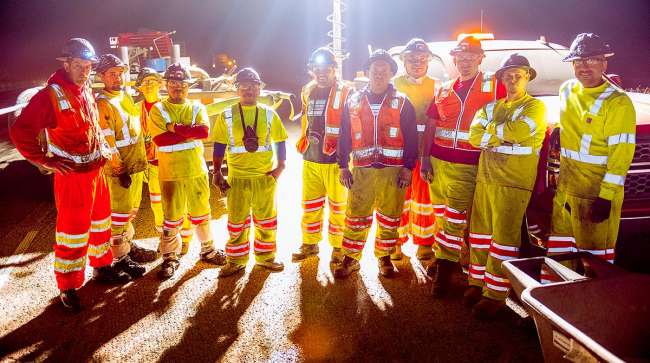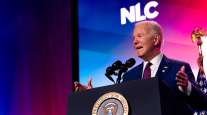Trump’s Planned Infrastructure Boom Bumps Up Against Worker Shortage

President Donald Trump’s plan to boost the economy with millions of jobs rebuilding roads, bridges and ports has a snag, the construction industry says: There aren’t nearly enough skilled workers to fill them.
Companies including AECOM, Skanska USA Inc. and Turner Construction Co. say the industry is hard-pressed to find enough people for current openings, let alone with the expansion Trump envisions with an additional $1 trillion in spending over the next decade. And though its full impact isn’t yet clear, rebuilding efforts from Hurricane Harvey are likely to increase the demand for workers in the coming years.
“I don’t think we could even dream of finding enough people,” said Richard Cavallaro, president and CEO of Skanska USA Civil, said of Trump’s plan to employ millions. “I just don’t think it’s going to happen like that.”
With the U.S. economy at close to full employment, economists say there aren’t millions of unemployed people looking for construction jobs — there were about 225,000 unfilled posts in June, according to the Bureau of Labor Statistics. That’s only slightly down from a nine-year peak of 238,000 openings in July 2016, data show.
On top of that, about 3 million of the current 14.5 million construction workers will retire or leave the industry over the next decade and need to be replaced, according to Joseph Kane, a former economist at the BLS who is now at the Brookings Institution in Washington. “There really isn’t a lot of breathing room in that market,” he said.
The administration’s immigration policies could compound the stress by making it more difficult to bring in qualified workers from other countries, said Stacey Bledsoe, director of human resource services for PCL Construction in Denver. In 2014, almost one of every four construction workers was an immigrant, according to a Pew Research Center analysis of government data.
Companies have already been reaching for whatever levers they can find to draw workers. Because firms are competing to secure subcontractors, New York-based Turner Construction has a program to pay them more quickly than other companies to ensure their availability, said Attilio Rivetti, vice president and director of preconstruction and estimating. Turner is also doing more prefabrication and modular work off site to make working conditions more attractive, he said.
College Partnership
AECOM Chairman and CEO Michael Burke said his company aims to fill more than 3,000 positions in the U.S. and Canada this year in anticipation of more infrastructure spending. The firm is partnering with the Los Angeles Community College District to help prepare students for infrastructure-related jobs.
JAR Construction Inc., a family-owned firm with 120 employees in El Paso, Texas, is taking a different approach. It’s offering to make the monthly student debt payment for some new hires because it can’t match the starting salaries of larger competitors, said Angelica Rosales, director of business development.
“In this day and age, especially when you don’t have as deep pockets as some of your competitors, you’ve got to get creative with your perks and your incentives,’’ Rosales said.
A survey by the Associated General Contractors of America released Aug. 29 showed that 70% of construction firms are having a hard time finding qualified workers, and 67% predict the difficulty will continue or worsen during the next 12 months.
Adding to that, hurricane recovery efforts in Texas will likely divert workers from projects in Texas and other states, Ken Simonson, the group’s chief economist, said on a conference call with reporters on Aug. 29. “It’s certainly going to exacerbate the workforce shortage.”
Watching Closely
Contractors are ready to beef up their training and recruitment efforts should Trump’s proposal become a reality, said Brian Turmail, spokesman for the contractors’ group.
The president signed an executive order June 15 to expand apprenticeships and reform “ineffective” programs. The order calls for the development of training programs by third parties with expedited and streamlined registration to get federal funding.
Still, the order says applications could be denied in any sector where programs “are already effective and substantially widespread” — meaning it may not apply to the construction industry, which has established programs run by organized labor, Turmail said.
The White House hasn’t clarified the language and referred questions about the order and its implementation to the Department of Labor. The order envisions the creation and the expansion of apprenticeship in all industries, with an emphasis on growing programs in new industries, the department said in a statement.
Legislative Schedule
The construction industry likely has some time. National Economic Council Director Gary Cohn told reporters Aug. 15 that he hopes to see an infrastructure bill start in the House after that chamber passes a tax measure this fall. But neither piece of legislation has been drafted.
The administration is holding a meeting with about 100 state and local transportation and other government officials on Aug. 30 to solicit feedback and explain the administration’s approach, according to a White House official speaking about plans that are not yet final.
Even so, Congress must deal with passing a budget and raising the debt ceiling when it returns from its summer recess in September, raising doubts that the tax overhaul will be completed in 2017. Treasury Secretary Steven Mnuchin signaled Aug. 25 that the end-of-year timeline may not be a firm deadline.
It also takes time to secure money and approval for projects and to design them, which allows companies to move craft workers to markets where there’s a need or ramp up their recruitment and training efforts as required, executives said.
“The good news about infrastructure is it’s long lead time,” Burke said. “You won’t start putting a shovel in the ground for a quite some time.”
With assistance by Sho Chandra




